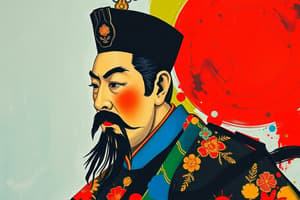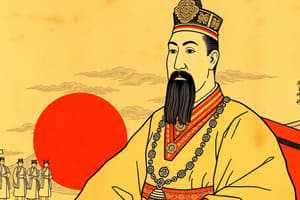Podcast
Questions and Answers
Which group primarily benefited from Japan's increasing wealth under the shoguns?
Which group primarily benefited from Japan's increasing wealth under the shoguns?
- Merchant class
- Artisans
- Military officials (correct)
- Poor farmers
What type of goods did artisans produce during Japan's shogunate period?
What type of goods did artisans produce during Japan's shogunate period?
- Food supplies and clothing
- Pottery and textiles (correct)
- Weapons and armor
- Books and manuscripts
Which religious influence played a significant role in shaping Japanese culture introduced from China?
Which religious influence played a significant role in shaping Japanese culture introduced from China?
- Christianity
- Zen Buddhism (correct)
- Confucianism
- Daoism
How did women's status change as Japan transitioned to a warrior society?
How did women's status change as Japan transitioned to a warrior society?
Which religions were integral to daily life in Japan during the shogunate period?
Which religions were integral to daily life in Japan during the shogunate period?
In what way were Japanese arts and architecture influenced during the shogunate period?
In what way were Japanese arts and architecture influenced during the shogunate period?
What was one significant impact of Prince Shotoku's governance reforms?
What was one significant impact of Prince Shotoku's governance reforms?
When did Japan see the construction of a new capital city modeled after Chinese urban planning?
When did Japan see the construction of a new capital city modeled after Chinese urban planning?
Which code patterned Japan's legal system after Chinese law during the Nara period?
Which code patterned Japan's legal system after Chinese law during the Nara period?
Who emerged as a notable figure during the period of civil unrest in Heian-kyo?
Who emerged as a notable figure during the period of civil unrest in Heian-kyo?
What event marked the beginning of Minamoto Yoritomo's shogunate?
What event marked the beginning of Minamoto Yoritomo's shogunate?
How were the Mongol invasions of the 1200s repelled during the Kamakura shogunate?
How were the Mongol invasions of the 1200s repelled during the Kamakura shogunate?
Which form of governance followed the collapse of the Ashikaga shogunate?
Which form of governance followed the collapse of the Ashikaga shogunate?
Who led the final unification of Japan after the period of warring daimyo?
Who led the final unification of Japan after the period of warring daimyo?
Flashcards are hidden until you start studying
Study Notes
Prince Shotoku's Influence
- In 593 C.E., Prince Shotoku became regent and introduced Confucian principles from China into Japanese governance.
- He established a constitution centralizing power in the emperor and setting out duties based on Confucian ideals.
- His reforms led to the Taika changes in 646 C.E., dividing Japan into districts under imperial control and establishing a tax system.
The Nara Period
- The Nara period in the 700s C.E. saw the construction of a new capital city, Nara, with Chinese-style architecture and urban planning.
- Japanese emperors built a hierarchical government, distributing land to officials who supported the emperor, thus consolidating land control.
- The Taihō code was adopted, patterning the legal system after Chinese law, including penal laws.
Rise of Military Leadership
- Heian-kyo (later Kyoto) became the capital in 794 C.E., mirroring major Chinese cities.
- Diminishing imperial power led to regents handling governance, allowing emperors to pursue cultural interests.
- Women warriors, such as Tomoe, emerged during civil unrest.
Shogunate and Samurai
- By the 1100s, noble families fought for land and influence, culminating in Minamoto Yoritomo becoming the first shogun in 1192 C.E.
- Yoritomo set up a dual government system, with the Kamakura shogunate facing Mongol invasions in the late 1200s, repelled in part by typhoons termed "kamikaze."
A Divided Japan
- The Kamakura shogunate ended in 1333 C.E., succeeded by the weaker Ashikaga shogunate, leading to territorial fragmentation controlled by daimyo.
- Feudalism developed, with samurai pledging service to daimyo in exchange for land.
- The Ashikaga shogunate's collapse led to a few powerful daimyo vying for control, eventually leading to unification under Tokugawa Ieyasu in 1603 C.E.
Society Under the Shoguns
- Japan's wealth increased under the shoguns, but was concentrated among the emperor, nobility, military officials, and a growing merchant class.
- The majority of the population were poor farmers, artisans, or traders.
- Artisans produced specialized goods such as pottery and textiles, with trade routes extending to Korea, China, and Southeast Asia.
Women's Roles
- Women's status fluctuated, enjoying higher social standing and property rights under Prince Shotoku but losing freedoms as Japan transitioned to a warrior society.
- Within farming communities, women had more influence in family matters but endured hard labor.
Religion and the Arts
- Religion, particularly Buddhism and Shinto, was integral to daily life and influenced the arts.
- The introduction of Zen Buddhism from China had a significant impact on Japanese culture.
- Japanese arts and architecture were heavily influenced by Chinese culture, leading to a period of flourishing religious and artistic expression.
Studying That Suits You
Use AI to generate personalized quizzes and flashcards to suit your learning preferences.




